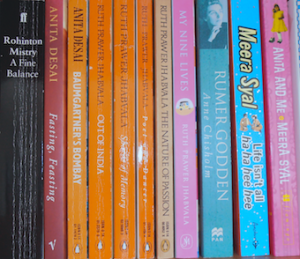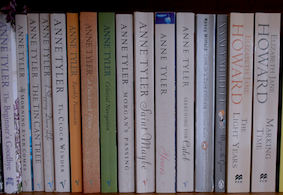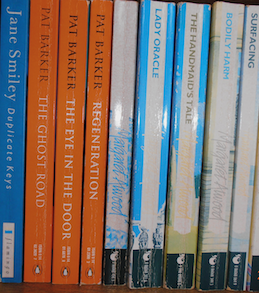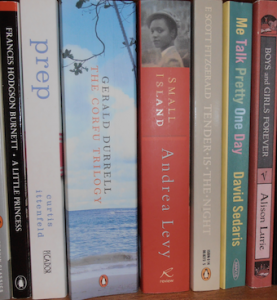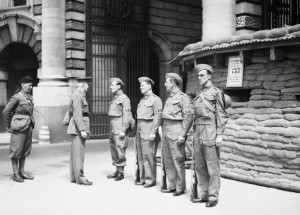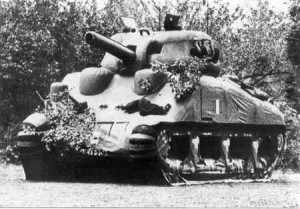Michelle Cooper's Blog, page 28
November 1, 2012
Pigeon Power
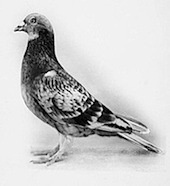
Commando, one of the British pigeons who served in the National Pigeon Service during WWII
Carrier pigeon’s skeleton sparks WWII code mystery!1 Pigeons AND coded messages! My favourite kind of news article! Poor brave little pigeon.On a cheerier note, here’s a news reel of some valiant pigeons who did make it home. It shows pigeons Gustav and Paddy being presented with the Dickin Medal, the animal version of the Victoria Cross.
_____
Thanks for the link, Zoe. ↩
October 25, 2012
Miscellaneous Montmaravian Memoranda
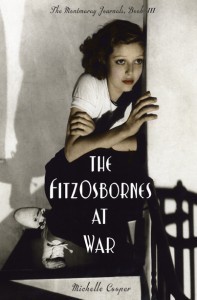 - The FitzOsbornes at War has been getting some nice reviews in North America, including a starred review in Kirkus and reviews at The Book Smugglers and Tea Cozy.
- The FitzOsbornes at War has been getting some nice reviews in North America, including a starred review in Kirkus and reviews at The Book Smugglers and Tea Cozy.
- I also loved this post about the British Ministry of Food at The Children’s War, which was inspired by Sophie FitzOsborne’s wartime job. There’s an inspirational advertising poster (“HELP WIN THE WAR ON THE KITCHEN FRONT”), a photo of a Victory garden, a video discussing the Ministry of Food, and best of all, some examples of the Food Facts that were published in The Times (“Good News About Carrots”). The Children’s War is also a terrific resource if you’re looking for children’s and YA books about the Second World War.
- Meanwhile, over at My Book, The Movie, I’ve been talking about the (hypothetical) casting of the (hypothetical) movie of The FitzOsbornes at War.
- And I’ve now set up a Montmaray Q & A page for anyone who wants to ask me questions about the series (beware, it contains plot spoilers for all three books, especially the last book).
October 21, 2012
Bookshelf Neighbours
I loved this article1 by Geraldine Brooks about her method for shelving her books, which even she admitted was “eccentric”:
“I start out conventionally enough, alpha by author. But while I take account of the first letter of the writer’s surname, I have other ambitions for my shelves that transcend the conveniences of mere alphabetical accuracy. It’s impossible for me to place one book alongside another without thinking about the authors, and how they would feel about their spine-side companion.
I arrange my shelves as I would seat guests at a dinner party. Anne Tyler and Anthony Trollope both seem devoted to a diligent scrutiny of manners. So I imagine them, shelved side by side, comparing notes on the mores of their respective eras . . .”
This sent me off to examine my own bookshelves. As organised as I am in many other aspects of my life, I have never attempted to shelve my books alphabetically, or by any other method recognised by librarians. I do tend to arrange books about similar topics in the same general area. For example, here is part of my ‘Indian fiction’ section, containing Rohinton Mistry, Anita Desai, Ruth Prawer Jhabvala, Rumer Godden (well, her biography) and Meera Syal, with Hanif Kureishi and Salman Rushdie lurking just out of sight:
(Mind you, Vikram Seth and the remainder of my Ruth Prawer Jhabvala collection sit on various shelves below this. I have no idea why.) I also have a ‘YA fiction’ section, a ‘dictionaries and other reference books’ section and two shelves of 1930s and World War Two books. I also try to shelve books by the same author together:
Oh, I seem to own a lot of Anne Tyler’s books. I’m not sure how she’d fare if seated next to Nancy Mitford at a dinner party (Nancy was not very fond of Americans), but perhaps Elizabeth Jane Howard, on the other side, could draw Nancy into a discussion about Paris fashions. I’d be more interested in eavesdropping on a dinner conversation between these three women:
Especially if they were talking about writing historical fiction. I also have Germaine Greer sitting next to Gloria Steinem, and Stella Gibbons beside Mary Renault.
But the rationale for the shelving of other books may be less obvious. For example, what do Frances Hodgson Burnett, Curtis Sittenfeld, Gerald Durrell, Andrea Levy, F. Scott Fitzgerald, David Sedaris and Alison Lurie have in common?
They’ve written books that are the same height, of course!
_____
Thanks to Bookshelves of Doom for the link. ↩
October 11, 2012
My Favourite Novels About Britain At War
1. Small Island by Andrea Levy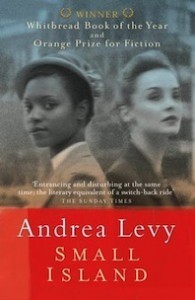
Jamaican airmen stationed in England during the Second World War find that the ‘Mother Country’ is less welcoming than they’d expected.
2. The Charioteer by Mary Renault
A soldier wounded at Dunkirk and recovering in an English hospital falls in love with a conscientious objector working as a hospital wardsman.
3. Marking Time and Confusion from the Cazalet Chronicles by Elizabeth Jane Howard
The Cazalet family’s privileged lives are changed forever when England goes to war.
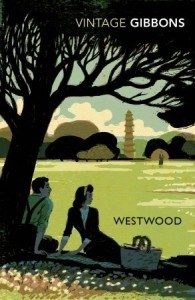 4. Westwood by Stella Gibbons
4. Westwood by Stella Gibbons
Plain, bookish Margaret and her beautiful friend Hilda are drawn into the orbit of a pompous playwright in Blitz-battered London – but who is exploiting whom?
5. The Night Watch by Sarah Waters
Four Londoners – all on the outskirts of society because they’ve fallen in love with the wrong people, all terribly damaged by the war – have their interlinking stories gradually revealed in a clever narrative that travels backwards through the 1940s.
October 10, 2012
Britain at War: Bletchley Park
The code-breaking work done at Bletchley Park during WWII is said to shortened the war by several years. It told the British where German U-boats were during the Battle of the Atlantic, helped them defeat Rommel’s forces in North Africa, and allowed the Allied strategists to plan the 1944 D-Day landings.
To encode their messages, the German military used rotor machines, the most famous of which was Enigma. The Enigma codes should have been unbreakable, but luckily, Polish intelligence had managed to work out Enigma before the war and had passed on all their information to the Allies. Then the British managed to capture a German U-boat in 1941, complete with an Enigma machine and code book. A large electromechanical device called the Bombe was used at Bletchley to work out which daily settings the Germans were using on their Enigma machines, and the deciphered messages were translated into English and sent off to high-ranking British military leaders.
Bletchley was staffed by thousands of ‘boffins and debs’, who took their vows of secrecy so seriously that it wasn’t until the 1970s that the general public began to learn about their remarkable achievements. Many of the ‘debs’ who worked there had been recruited because of their social connections (“they were really frightfully snobbish about the girls who worked there”1). Other workers were recruited due to their linguistic or mathematical skills, with several of them identified after winning a national crossword competition. Among the ‘boffins’ was the brilliant mathematician Alan Turing, who was greatly admired by one of the debs, Sarah Norton:
“I once offered him a cup of tea but he shrank back in fear. He seemed terrified of girls and on the rare occasions when he was spotted, like a protected species, he would be shambling down to the canteen in a curious sideways step, his eyes fixed on the ground. It was explained to me that if you had spent most of your adult life closeted away in a study in Cambridge, you too would be scared of women and not know how to handle them.”2
Or, you know, you might be gay, which was then illegal. Sadly, Alan Turing was arrested after the war for consensual sex with another man, lost his high-security job, was given a choice of imprisonment or chemical castration, and killed himself. The laws against homosexuality were applied very selectively in those days. It was much easier to get away with being same-sex-attracted if you were rich and royal, like Prince George, Duke of Kent.
Tomorrow: My favourite novels about Britain at war.
_____
Jean Campbell-Harris, quoted in Anne de Courcy’s Debs at War ↩
Sarah Norton, quoted in Anne de Courcy ↩
October 9, 2012
Britain at War: The Home Guard
Today, I’m going to be talking about Dad’s Army . . . I mean, the Home Guard, a defence organisation made up of British men who were too old, too young or otherwise ineligible to join the regular British Army. The Home Guard (initially called the ‘Local Defence Volunteers’, or LDV) was formed in 1940, when there was a real fear that Britain was about to be invaded by Germany. By that time, the Nazis had overrun Czechoslovakia, Poland, Norway, Luxembourg, Belgium, the Netherlands and France, while most of the rest of Europe was ruled by dictators who supported Hitler. The British government called for volunteers to ‘defend our island’ and was overwhelmed by the enthusiastic response.
Local Defence Volunteers in London, 1940
At its peak, the Home Guard had nearly two million members. Unfortunately, the government was struggling to provide enough uniforms and rifles to the regular army (they’d lost quite a lot of equipment in their hasty withdrawal from Dunkirk), so the Home Guard had to improvise. They made bombs out of jam jars and beer bottles filled with petrol, borrowed ancient weapons from local museums, and sharpened up their pitchforks and kitchen knives. In June 1940, Churchill ordered that “every man must have a weapon of some sort, be it only a mace or a pike”, so 250,000 ‘pikes’ (obsolete bayonets welded to long steel tubes) were dutifully ordered (although never actually distributed to the Home Guard).The Home Guard set up watch posts in coastal towns and erected roadblocks, but some of them were a little too enthusiastic in carrying out their duties:
“. . . on the night of 2/3 June 1940, LDVs shot and killed four motorists at separate locations; on 22nd June it was reported that two motorcyclists and their passengers had been killed and wounded in the north of England and in Scotland; on 26 June an ARP [Air Raid Precautions] warden was shot dead when he ignored (or maybe didn’t hear) an LDV challenge; and in Romford in Essex a car exhaust backfiring prevented the driver hearing the command to stop: four passengers were shot dead and a fifth seriously wounded.”1
The Home Guard did even more damage to themselves, as can be seen here. Although the Germans never invaded Britain, over 1,600 Home Guardsmen were killed on duty, often by self-inflicted injuries.
Officially, women weren’t allowed to join the Home Guard because it would be “abhorrent” for a female to bear arms. “What about Boadicea?” pointed out Labour MP Edith Summerskill, but she was ignored. Eventually a Women’s Home Guard Auxiliary was formed, but women who joined were only allowed to perform traditional womanly duties such as cooking, cleaning and taking telephone messages. This did not deter Marjorie Foster and her fellow female patriots, who set up the Amazon Defence Corps and trained women in the arts of musketry, bombing and unarmed combat. Henry FitzOsborne would have approved.
Tomorrow: Bletchley Park
_____
Juliet Gardiner, Wartime Britain 1939-1945 ↩
October 8, 2012
The FitzOsbornes at War, Plus My Favourite Non-Fiction About WWII Britain
The final book in the Montmaray Journals trilogy, The FitzOsbornes at War, is released in North America today. Hooray!
‘The FitzOsbornes at War’, published in North America on October 9, 2012
This edition is pretty much the same as the Australian edition (apart from the cover art and the American spelling and punctuation, of course), but one difference is that it contains a family tree for the FitzOsborne family, dated 1955. As I don’t want those who bought the Australian edition to miss out, I’ve now posted a version of that family tree on my author website. (Please note that the family tree contains plot spoilers for all three books, so it’s not a good idea to click on that link until you’ve read all three books. Unless you’re the sort of reader who always reads the last pages of a novel first – in which case, go ahead and click.)Now that the trilogy is finished, does anyone want to ask me any questions about the Montmaray books? I could set up a separate page on this blog with a big spoiler warning. If anyone thinks that’s a good idea, leave a comment below, and I’ll start a Montmaray Q & A page. (Of course, you can continue to email me with questions, but I thought it might be more efficient if everyone could read the questions and answers, especially as people tend to ask the same questions.)
Meanwhile, if you’re interested in how I went about researching, planning and writing The FitzOsbornes at War, I wrote a series of blog posts about it earlier this year. And here are my five favourite non-fiction books about Britain during WWII:
1. Debs at War 1939-1945: How Wartime Changed Their Lives by Anne de Courcy
The privileged young British women who joined the services, drove ambulances, built aircraft in factories, nursed the wounded and worked on farms during the war tell their stories.
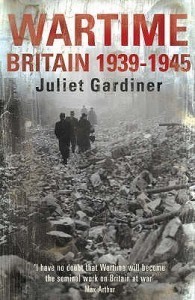 2. Wartime Britain 1939-1945 by Juliet Gardiner
2. Wartime Britain 1939-1945 by Juliet Gardiner
A meticulously researched account of every aspect of life on the Home Front, from the blackout, rationing and the Blitz, to the experiences of ‘enemy aliens’ and prisoners of war in Britain.
3. Voices from the Home Front: Personal Experiences of Wartime Britain 1939-1945 by Felicity Goodall
Moving stories taken from the letters and diaries of ordinary British people living through extraordinary hardships.
4. Keep Smiling Through: The Home Front 1939-45 by Susan Briggs
A fascinating and well-organised collection of wartime photos, cartoons, advertisements, posters, pamphlets and songs.
5. Sea Dog Bamse: World War II Canine Hero by Angus Whitson and Andrew Orr
The story of Bamse, a charismatic St Bernard who was an official crew member of the minesweeper Thorodd and a mascot to the Free Norwegian Forces stationed in Scotland during the war.
Tomorrow: The Home Guard
October 7, 2012
Britain at War: Masters of Illusion
This week, to mark the release of the North American edition of The FitzOsbornes at War, I’m going to be blogging about Britain during the Second World War. Today, it’s all about the artists who used their skills to camouflage buildings, guns, lorries, tanks, canals – and even entire cities – to protect them from Nazi attacks. Among these artists was the surrealist painter Julian Trevelyan, who was sent on a military camouflage training course in 1940. He learned how animals camouflage themselves in the wild with protective colouring, then was sent off with his paint tins and brushes to work in Cornwall, where he disguised concrete forts as cottages, public toilets and chicken houses, and used careful countershading to render anti-tank guns invisible against hedges. He also gave lectures to soldiers, showing them slide shows of how to camouflage themselves from air attacks (making sure he included slides “of nude girls under a camouflage net to wake up the men when they had dropped off”1). He was later stationed in North Africa and Palestine, where he disguised military tanks and created a dummy army to deceive the German Afrika Korps.
A dummy inflatable tank used by the Allies during WWII
Camouflage was also an essential part of Operation Normandy, the Allied invasion of occupied France and Belgium in 1944. The Allied strategists went to great lengths to fool the Germans into thinking the Allied troops would depart from Dover and land in Calais. There were hundreds of fake plywood planes stationed on Kent airfields, as well as dummy landing craft floating on the Thames. They set up inflatable rubber tanks and lorries to make it look as though the Allies had more equipment than they actually possessed, and the 82nd Group Camouflage Company spent weeks making fake tyre marks in the grass so that it would appear that an enormous army had been practising manoeuvres. They also built a huge fake oil-storage tank in Dover, which was regularly ‘inspected’ by the King and Queen for the benefit of German spies.One of the most famous camouflage experts of the war was magician Jasper Maskelyne, who was recruited into the British army at the same time as Julian Trevelyan. Maskelyne had been particularly bored during the animal-camouflage lectures of their training course (“a lifetime of hiding things on the stage had taught me more about the subject than rabbits and tigers will ever know”2), but he went on to disguise military equipment in the Western Desert and even claimed that he’d made the city of Alexandria temporarily ‘disappear’. He truly was a Master of Illusion.
Tomorrow: Publication day for The FitzOsbornes at War! Also, I talk about some of my favourite non-fiction books about wartime Britain.
_____
Julian Trevelyan, Indigo Days, quoted in Juliet Gardiner’s Wartime Britain 1939-1945 ↩
Jasper Maskelyne, Magic – Top Secret, quoted in Gardiner ↩
September 18, 2012
Why I Love Alice
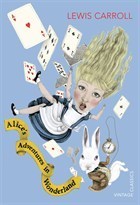 (The Alice who has Adventures in Wonderland, that is.) I’ve written a blog post about why I love Alice here to celebrate the release of the new Vintage Classics edition of this utterly brilliant book.
(The Alice who has Adventures in Wonderland, that is.) I’ve written a blog post about why I love Alice here to celebrate the release of the new Vintage Classics edition of this utterly brilliant book.
A confession: As much as I love Alice’s Adventures in Wonderland, my favourite Alice book is actually Through the Looking Glass. (The Red Queen! Humpty Dumpty! Jabberwocky! The White Knight! The Anglo-Saxon Messenger with his Anglo-Saxon attitudes and his bag of ham sandwiches and hay!) But sadly, there isn’t a Vintage Children’s Classics edition of Through the Looking Glass.
Extra note: if you know any artistic Australian students in Years Three to Six, you might like to draw their attention to this competition being run by Random House. Students are asked to choose their favourite title from the Vintage Children’s Classics collection, then send in a design for their own cover, with big book prizes for them and for their school. Entries close on the 1st of October. (If I were entering, I probably wouldn’t choose Black Beauty or The Wish Pony, because horses are really hard to draw. I would probably choose Treasure Island, because I like drawing pirates and parrots. Or maybe A Brief History of Montmaray, because it has pirates and puffins.)
September 13, 2012
A. A. Milne On Writing
“Writing, let us confess it unashamed, is fun. There are those who will tell you that it is an inspiration, they sing but as the linnet sings; there are others, in revolt against such priggishness, who will tell you it is a business like any other. Others, again, will assure you (heroically) that it is an agony, and they would sooner break stones – as well they might. But though there is something of inspiration in it, something of business, something, at times, of agony, yet, in the main, writing is just thrill; the thrill of exploring. The more difficult the country, the more untraversed by the writer, the greater (to me, anyhow) the thrill.”1
Of course, writing tends to be more of a thrill when the writer has a history of critical and commercial success, and knows his next work is eagerly awaited:
“He had always written what he wanted to write. His luck was that this was also what the public wanted to read.”2
A. A. Milne didn’t simply enjoy writing; he also believed writing (and writers) were of great value to society, and sometimes had the need to remind others of this:
“Authors have never been taken very seriously by their fellow-men. ‘A singer is a singer,’ the attitude seems to be, ‘a painter is a painter, and a sculptor sculpts; but dash it all, a writer only writes, which is a thing we all do every day of our lives, and the only difference between ourselves and Thomas Hardy is that Hardy doesn’t do anything else, whereas we are busy men with a job of real work to do.’ And since writing is, in a sense, the hobby, or at least the spare-time occupation of the whole world, it has become natural for the layman to regard the professional author as also engaged merely upon a hobby, the results of which, in accordance with the well-known vanity of the hobbyist, are free for the inspection of anyone kindly enough to take an interest in them.
For instance, you who read this would not think of asking a wine merchant, whose nephew had been at the same school as your son, for a free dozen of champagne on the strength of that slight connection; but you would not hesitate to ask an author, similarly connected, for a free article for some ephemeral publication in which you were interested, or for permission to perform his play without the usual payment of royalty. Indeed, you would feel that you would be paying him the same sort of compliment that I should be paying you if, dining at your house, I asked to see the fretwork soap-dish in your bathroom. ‘Oh, are you really interested?’ you would say. ‘Fancy your having heard about it. How awfully nice of you!”
This was after yet another of his tussles with the BBC, which paid nominal or no fees to authors when their works were broadcast, and took, according to him, the following attitude:
“If we pay you a fee, we won’t mention your name or your works or your publishers or anything about you, but if you will let us do it for nothing we will announce to our thousand million book-buying listeners where your book is to be bought. And if you don’t like it, you can leave it, because there are plenty of other authors about; and, if it came to the worst, we could write the things ourselves quite easily.”3
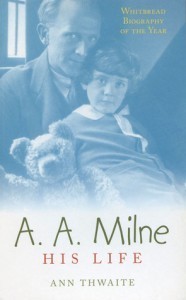 What would Mr Milne have made of the internet?
What would Mr Milne have made of the internet?
All the above quotes are from Ann Thwaite’s excellent biography of A. A. Milne, who was the author of Winnie-the-Pooh, When We Were Very Young, Peace with Honour and dozens of poems, articles, essays, plays and short stories.
_____
A. A. Milne, quoted in The Path Through the Trees by Christopher Milne, 1979 ↩
The Enchanted Places by Christopher Milne, 1974 ↩
Evening News article, reprinted in The Author, April, 1926 ↩

